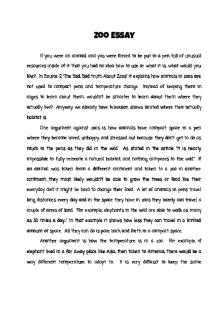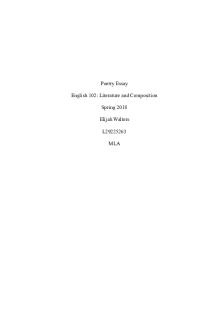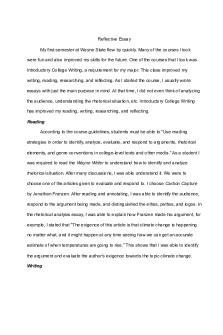Out of Class Essay #4 - Grade: B PDF

| Title | Out of Class Essay #4 - Grade: B |
|---|---|
| Author | Corinne Pierson |
| Course | English I |
| Institution | Raritan Valley Community College |
| Pages | 7 |
| File Size | 147.7 KB |
| File Type | |
| Total Downloads | 47 |
| Total Views | 145 |
Summary
english...
Description
Pierson 1
Corinne Pierson Prof Berezowsky English Composition I 27 November 2018 Out of Class Essay #4 Racism and prejudice have been present in almost every environment and society throughout history. Even though the world has progressed greatly in the last couple of decades, both socially and technologically, racism, hatred and prejudice still exists today all around us in every society. Zora Neale Hurston writes about this in her essay, “How It Feels to Be Colored Me”. Hurston reflects that during her childhood she was taught to love herself and the color of her skin but after her mother passed away she soon quickly saw how society viewed people with her skin color and this leads her to question who she really was. The environment is what will always be with you no matter your situation. No matter where you are in the world, whether it be Madrid, Spain or Las Vegas, Nevada, the environment will always surround you. All throughout our environment, people are surrounded by what they believe is the right thing to do. The society in our environment is told by their parents or those around them what they should believe in. But Hurston, shares her personal thoughts on how people should identify themselves, no one should have to hide their face to feel confident just like no one should have to hide their cultural beliefs in fear of getting treated poorly by others. People would rather follow how other people think and feel than to have their own opinion on something. Zora N. Hurston was born in an all-black community in Florida, she did not have much
Pierson 2
reason to consider her race until she left home at age thirteen to go to boarding school in Jacksonville. While in her hometown, Hurston had nothing to worry about. Everyone around her was exactly like her and no one was judging her. Hurston was, “everybody’s Zora,” but when she got to Jacksonville, her race was no longer around her. There were several different types of people around her in which she did not know about. Hurston states, “I was not Zora of Orange County any more, I was now a little colored girl.” (Hurston). This explains how we are always more comfortable when we are around people that have the same qualities as us rather than people who differ from us. Mary Jo Kreitzer states, “Since the earliest times, humans have needed to be sensitive to their surroundings to survive, which means that we have an innate awareness of our environment and seek out environments with certain qualities. First of all, humans have a strong need for safety and security and look for those attributes in their environment. We also look for physical comfort, such as an environment with the right temperature”. (Kreitzer). This ties together with Hurston’s argument by explaining that people who are in environments that include different races than the race that they are, tend to feel very uncomfortable and judged because they realize just how different they actually are. Zora being a
“little colored girl” is not accepted by the whites in the town of Jacksonville. Zora also argues that race isn’t an essential feature that a person is born with, but instead emerges in specific social contexts. Rand D. Conger explains, “There are strong reasons to think that families, and their economic circumstances in particular, influence both parents’ and children’s emotions and behaviors”. (Conger). This means that most children’s behaviors are
Pierson 3
received from their parents. For example, if a parent is around their kids and they say a comment about a person of color being bad, their children will also believe that a person of color is bad. Most children look up to their parents and want to be just like them, this is how the environment you are around extremely affects you. Even though Zora considers her identity as a black woman, within time, Hurston gains the power to minimize or refuse the concept of race. She explains this by using the metaphor of the bag, isn’t about its appearance on the outside but what is inside. She describes the contents of a bag to a personality that is both positive and negative. Hurston states, “A first-water diamond, an empty spool, bits of broken glass.” Hurston’s point is that the outside of a bag has no effect on what is inside. She uses the metaphor of the bag to explain race as something that determines their personality not their appearance. As stated by Chu, “the environment serves as a reference guide for us on how we should act or respond.” (Chu). The problem with our environment is it shows no empathy for humans, as it can have an extremely negative effect on the life of someone. This also explains why people are bias with the color of people’s skin. In our environment, racism is a huge problem due to the fact that people assume since ones skin is not the same color as theirs than they do not deserve the time of day. The most minor details that you see everyday have the power to change who you are and the power to change your emotions. If you do something repeatedly for a long period of time, it eventually becomes a habit. We rely on these habits because our brains do not have much will power just by themselves. Making a choice in foreign situation requires a lot of brain power, and there us only so much you can use before it runs out. This a reason as to why the environment
Pierson 4
plays such a big role in the decisions you make. For example, if you want to start to eat healthier but a salad is $7 and a cheeseburger is $4, you will most likely choose the cheaper meal in order to save money. Even in little decisions like these, your environment affects what choices you make, therefore with big decisions like whether a person of color is “worth their time” isn’t even thought about, people just follow how others feel. Zora states, “Sometimes, I feel discriminated against, but it does not make me angry. It merely astonishes me. How can any deny themselves the pleasure of my company? It's beyond me” (Hurston 4). This proves that she is aware that society has a negative outlook on the color of her skin but she realizes it’s not her fault and she learns to not let the ignorance of society dictate how she views herself. In conclusion, there are several different reasons why racism is believed to be affected by the environment. People everywhere can not accept the fact that just because someone has a different skin color than you doesn’t mean that they are any less of a human as you are. This happens because of the way society is ran in these environments. Parents act these ways towards people of other races in front of their children which starts a chain reaction when their kids go and tell their friends. People of different races and color all over the world are experiencing the sadness of this society. Zora Neale Hurston deals with this first hand, and wrote this reading to try and inform others that no matter how people judge others by their face or skin color, there is much more to look at. Judging a book by it’s cover is a great example of this. No matter how good the book is on the inside, people will not read it if the cover is not up to their standards. She also touches base on the point that no matter what is going on in the environments surrounding us, she could find a way to be confident in her own skin. She did not let society dictate and
Pierson 5
decide what “normal” should be.
Works Cited Bickhard, Mark. “How Does the Environment Affect the Person?” https://www.lehigh.edu/~mhb0/EnvtoPerson.pdf Chu, Melissa. “Why Your Environment Is the Biggest Factor in Changing Your Life.” Inc.com, Inc., 21 Aug. 2017, www.inc.com/melissa-chu/its-possible-to-design-yourenvironment-to-help-yo.html
Hurston, Zora. “How It Feels to Be Colored Me.” 50 Essays: a Portable Anthology, 5th ed., Bedford/St. Martins, 2017, pp. 188–192.
Pierson 6
Institute of Medicine (US) and National Research Council (US) Committee onthe Science of Adolescence. “The Influence of Environment.” Current Neurology and Neuroscience Reports., U.S. National Library of Medicine, 1 Jan. 1970, www.ncbi.nlm.nih.gov/books/NBK53409/ Kreitzer, Mary Jo. “What Impact Does the Environment Have on Us?” Taking Charge of Your Health & Wellbeing, www.takingcharge.csh.umn.edu/explore-healingpractices/healing-environment/what-impact-does-environment-have-us
Source 1: MLA citation: https://www.takingcharge.csh.umn.edu/explore-healing-practices/healingenvironment/what-impact-does-environment-have-us Brief Summary of Text: (1-2 sentences in your own words: As humans we look into our environment for comfort and safety. If you feel safe in the environment you are in then you will live a comfortable life. Source 2 MLA citation: https://www.inc.com/melissa-chu/its-possible-to-design-your-environment-to-help-yo.html Brief Summary of Text: (1-2 sentences in your own words) Our environment is our biggest contributor into making who we are. It affects almost every decision we make everyday. Source 3
Pierson 7
MLA citation: https://www.lehigh.edu/~mhb0/EnvtoPerson.pdf Brief Summary of Text: (1-2 sentences in your own words) Our environment affects much more than just your emotions. Source 4 MLA citation: https://www.ncbi.nlm.nih.gov/books/NBK53409/ Brief Summary of Text: (1-2 sentences in your own words) All aspects of your environment affect who you are including your family and peers....
Similar Free PDFs

Out of Class Essay #4 - Grade: B
- 7 Pages

Rogerian Essay - Grade: B
- 2 Pages

Zoo Essay - Grade: B+
- 2 Pages

Causation Essay - Grade: B
- 4 Pages

Final Essay - Grade: B+
- 12 Pages

Propaganda Essay - Grade: b
- 4 Pages

Poetry Essay - Grade: B
- 5 Pages

Galileo Essay - Grade: B+
- 6 Pages

Fiction Essay - Grade: B
- 7 Pages

EPQ Essay - Grade: B+
- 10 Pages

Law essay - Grade: B
- 9 Pages

Persuasive Essay - Grade: B
- 3 Pages

Evicted Essay - Grade: B+
- 3 Pages

Charities essay - Grade: B+
- 13 Pages

Reflective Essay - Grade: B
- 4 Pages

Analysis essay - Grade: B+
- 3 Pages
Popular Institutions
- Tinajero National High School - Annex
- Politeknik Caltex Riau
- Yokohama City University
- SGT University
- University of Al-Qadisiyah
- Divine Word College of Vigan
- Techniek College Rotterdam
- Universidade de Santiago
- Universiti Teknologi MARA Cawangan Johor Kampus Pasir Gudang
- Poltekkes Kemenkes Yogyakarta
- Baguio City National High School
- Colegio san marcos
- preparatoria uno
- Centro de Bachillerato Tecnológico Industrial y de Servicios No. 107
- Dalian Maritime University
- Quang Trung Secondary School
- Colegio Tecnológico en Informática
- Corporación Regional de Educación Superior
- Grupo CEDVA
- Dar Al Uloom University
- Centro de Estudios Preuniversitarios de la Universidad Nacional de Ingeniería
- 上智大学
- Aakash International School, Nuna Majara
- San Felipe Neri Catholic School
- Kang Chiao International School - New Taipei City
- Misamis Occidental National High School
- Institución Educativa Escuela Normal Juan Ladrilleros
- Kolehiyo ng Pantukan
- Batanes State College
- Instituto Continental
- Sekolah Menengah Kejuruan Kesehatan Kaltara (Tarakan)
- Colegio de La Inmaculada Concepcion - Cebu